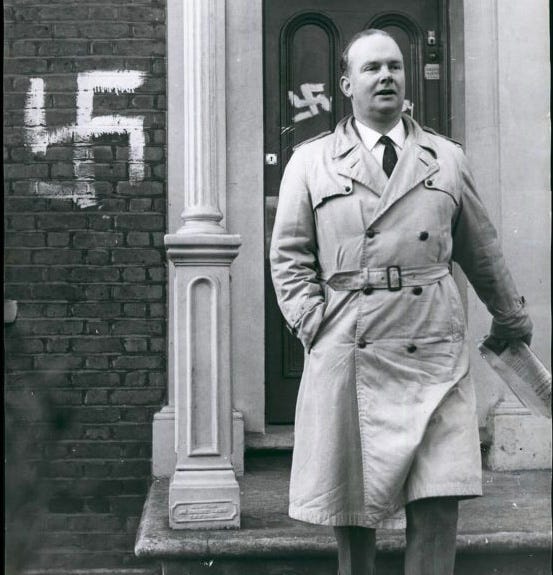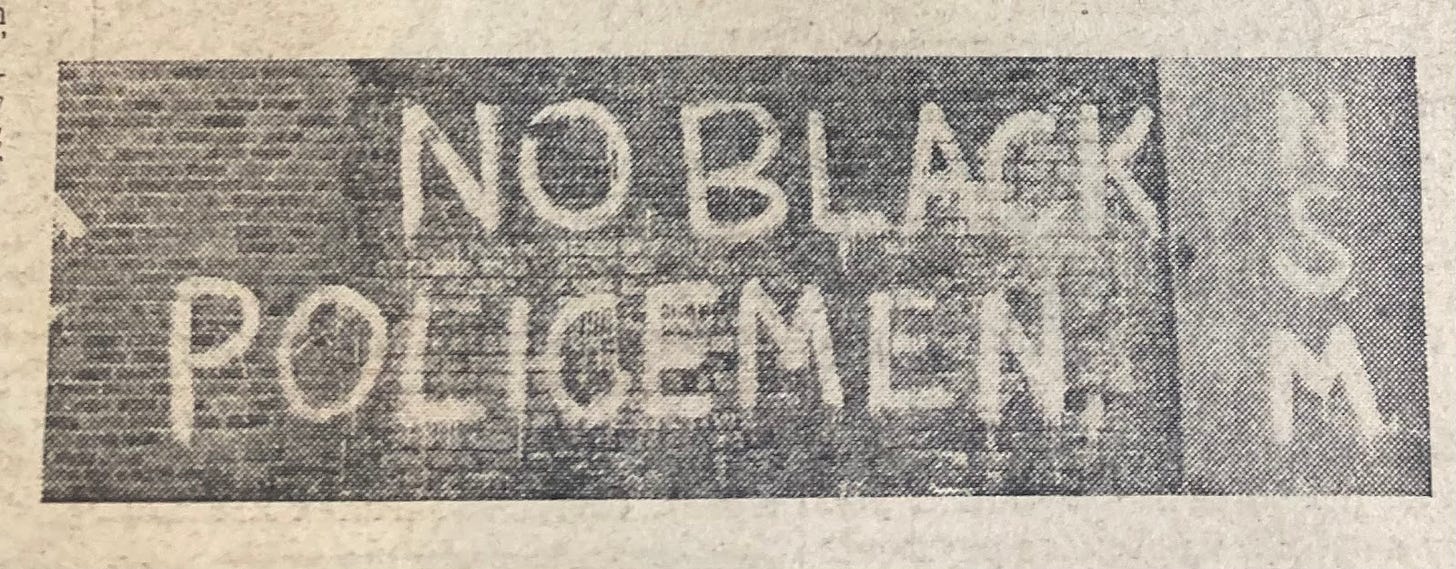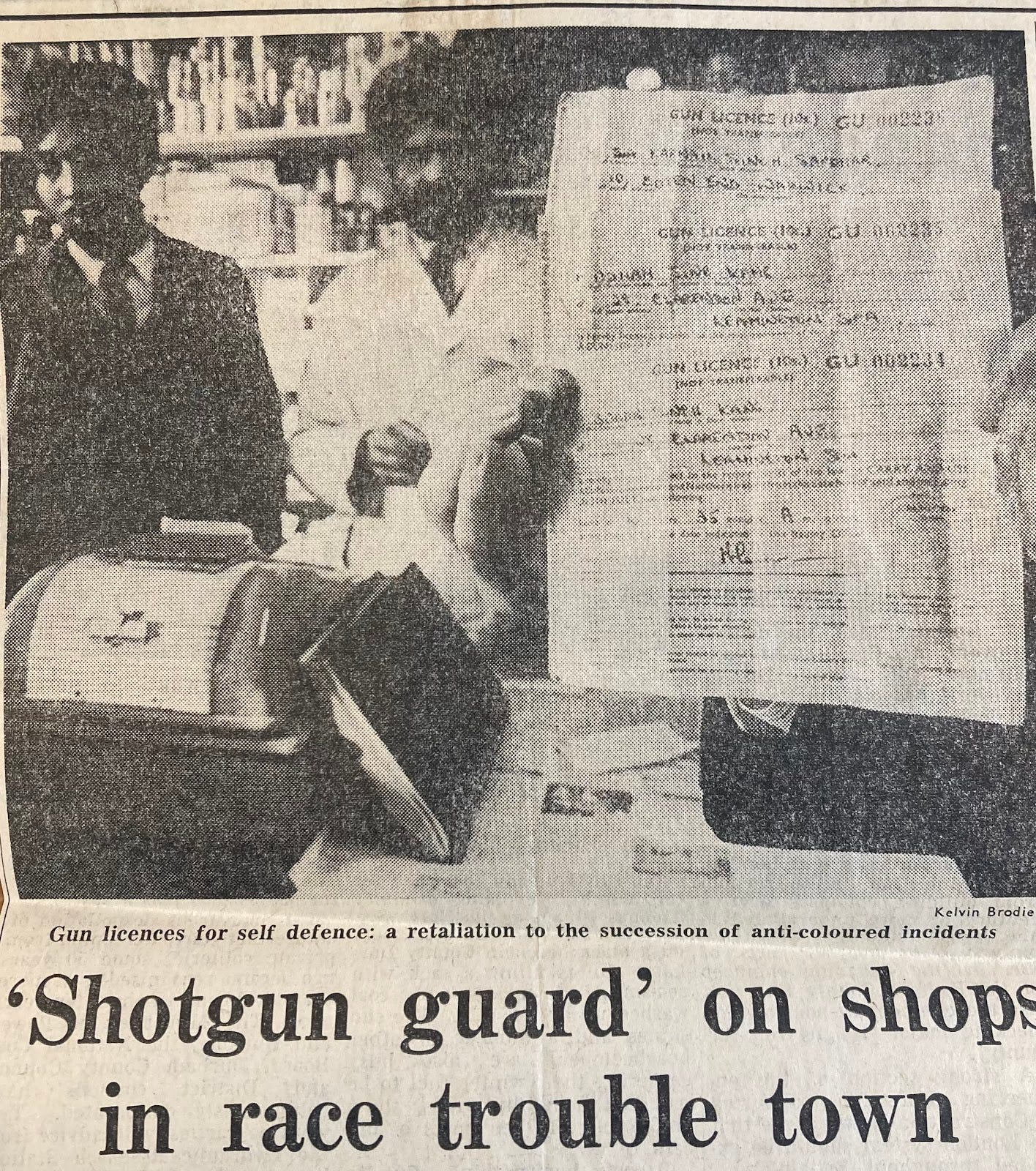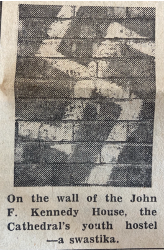The Ku Klux Klan in the Midlands: The Life of a British Klansman
Part 2a: Leamington Spa & Smethwick 1964-1966
There existed a certain interrelationship between the reactionary, racist opportunism of Peter Griffiths’ Conservative Party in Smethwick, Birmingham’s Ku Klux Klan and the regional Midlands fascists headed up by Colin Jordan. As was explained previously, the Klan were an offshoot of Colin Jordan’s National Socialist Movement. This Neo-Nazi organisation, along with its leader, played an important role in fostering the racism that came to characterise Smethwick in the sixties. The proliferation of their objectionable views was certainly aided by Griffith’s campaign, and so the two worked hand in hand to create, in the words of a concerned Dr. Dhani Prem, a town that threatened to become “as notorious [for racism] as Little Rock or South Africa or Rhodesia.”1 Indeed, Prem believed that Griffiths’ “victory… [was] an open invitation to extremism” which had, in fact, firmly cemented the town as a “symbol of race hatred… that… delight[ed] every fascist in Britain.”2 Thereby, this makes the history of the Birmingham KKK, although their activities ventured into other parts of the Midlands, inextricably linked to the historically parallel events of Smethwick.
Colin Jordan in Leyton January 1965
Evidencing this claim, during Griffith’s tenure as MP, people claiming to be Klan members, who were no doubt spurred on by the successful election of such a vile racist, threatened an Indian resident of Smethwick. The victim said he was told that they would be coming to burn his house down. An anonymous voice on the other side of the line said “we will kill you.”3 This threat is illustrative of the kind of attacks on black and Asian homes at the time, as discussed in Part 1, which happened with a frightening frequency.
These interrelations had implications, not just for the immediate future, which included the creation of Birmingham’s very own cloaked Klavern, but for much further into the future and more widely throughout other areas of the Midlands. This is shown through particular acts in the political life of the prominent Klansman, Robert Relf, who ties together the three different threads of Griffiths’, the KKK and regional fascism.
Malcolm X in Smethwick
Battling this trifecta were the likes of the Indian Workers’ Association, lead by Jagmohan Joshi and later Avtar Jouhl, who had invited esteemed activists like Malcolm X and Claudia Jones to Smethwick to raise awareness about the extremity of racism they were facing. The situation was so bad that on his visit Malcolm X infamously, and perhaps somewhat hyperbolically, compared Smethwick to Nazi Germany. Going further, he warned the “local coloured population… that they should not wait for Smethwick’s fascists to erect gas ovens before it organised itself.”4 Notably, Malcolm directly referred to Colin Jordan in his statements. Similarly, though put forth in less controversial language, after the first and “extremely serious”5 fiery cross attack in Leamington Spa, Joshi foresaw that: “A trend is developing which might lead to very dangerous consequences. An emotional element exposed to fascist ideologies is trying to develop a certain way of thinking.”6 In response to this threat he declared, “we will do everything possible to combat it.”7 One of the people whose life-long activities always had the potential for “dangerous consequences”, and was a long-time associate of Jordan, was a certain Robert Relf.8
Relf, who was present at the inaugural Klan meeting on June 12th 1965, had happened to be, in his own words, “walking with friends about 200 yards from the scene” when the “police stopped me… but I knew absolutely nothing at all about it.”9 The “scene” Relf had claimed to know nothing about was the first fiery cross attack of 1965 in Leamington Spa.10 Its target was Dharam Singh Roopra, a local Labour Party activist who the year prior had lost an election reportedly as “the first Sikh to contest an election in England.”11 While running his campaign he had been the victim of racist posters which stated “If you want a n****r for your neighbour, vote Labour.”12 This choice of phrase was undoubtedly inspired by the concurrent Conservative campaign in Smethwick and demonstrates how interconnected the racism of Griffiths’ campaign was, across the Midlands, to regional fascists, whom Singh believed to be responsible for the posters. Singh said he thought the perpetrators were “…childish and immature fascists who can only be treated with utter contempt.”13 However, once again, to refer to fascists as simply immature was to underestimate the danger they posed to the public at this time.
Dharam Singh Roopra, Leamington-based Indian activist
Coinciding with the posters targeting Singh, Relf had himself been “daubing colour bar slogans” and swastikas on walls in the area for which he, along with four others who were accused (which included Klan Spokesman George Newey and KKK Deputy John Richards), was fined.14 Colin Jordan, presumably as a gesture of support, “sat… in the public gallery… listening to… [the] case against [the] four men.”15 Relf refused to pay the fine and thus was imprisoned for three months and as a consequence he lost his job as a Midland Red Bus Driver. That Relf and his backward ilk were found to be plastering Leamington with hate around the same time that Singh was targeted, using a slogan that members of the National Socialist Movement would’ve been intimately aware of is unlikely to be fortuitous, though no definitive link can be made.
The Leamington fiery cross was described as just “the latest reported violence to which… coloureds have been subjected to in Britain’s industrial Midlands” as there had also been incidents in the town where “the windows of some Indian-owned ships were smashed… and anti-Indian slogans were daubed on walls” in the months leading up to the terror attack on Dharam Singh.16 The attack itself had caused “damage, estimated at £175” as a stone had been “heaved into the front room which was occupied by a medical student and “a burning cross six feet tall and four feet wide was placed against the front door.”17 The town had become a hot-bed for hate; likewise the town of Smethwick had gained worldwide notoriety for its race-based hatred and, I agrue, it cast a long, dark shadow over the Midlands, influencing and being a component part of the racism experienced elsewhere during the time. Indeed, a climate was being built in Leamington that had made Dr. Dhani Prem fearful that the “seeds of Smethwick were being sown.”18 One of these fruits of hate was borne out in an incident when a Pakistani man, Abdul Rahman Khan, had his shop blown to pieces in Smethwick in 1964.
This was not, as is apparent from the sheer number of stories, a kind of extreme racism or terror unakin to the British social landscape in the Sixties. Even Robert Relf had publicly admitted to engaging in terroristic activity when in January 1965 he, while in a self-described “terrible rage”, threw a thunderflash “bomb” at the then Foreign Secretary (and importantly the Labour MP who stood against Peter Griffiths in 1964), Patrick Gordon Walker, that he claimed to have learnt how to use while in the army.19 Although the bomb did not hurt anyone and Relf said he “knew the thunderflash was harmless”, this does not deter from the fact that he threw an explosive at a prominent politician and to my knowledge saw no jail time for this particular incident.20
Coincidentally, or perhaps not, almost year before this explosive incident, a “bomb hoax [had] closed… part of [Dudley] town’s central bus station” after a “bomb” was discovered in one of town’s public lavatories by a Midland Red Bus Conductor.21 An “expert” from the “Ammunition Inspectorate”, after dismantling the bomb, “said that it was harmless… [but] Whoever built this… had taken great care to make it look right, and it had been very cleverly been wired to look as though it was the proper job.”22 Left upon the contraption were the words, in red printing, “With patriotic compliments of [The] Grand Dragon and Aryan Knights Ku Klux Klan of Britain.”23 If that was not shocking enough it came with an “effigy of a mailed and mounted knight.”24 There are some striking similarities between this incident and certain actions taken by Robert Relf. How many other Klan sympathisers were there with knowledge of “harmless” weaponry, clearly intended to frighten, that had connections (albeit circumstantial) to the Midland Red Bus Company? Considering that only sixteen people showed up to the Chapel Pub meeting of June 12th 1965, the list of suspects is small. These incidents, again highlight the very real terror people faced, in Birmingham and the Midlands at large, as these were not simply disorganised hooligans, but violent, angry and in some cases militarily trained individuals.
In June 1965, the very night before the cross attack on Dharam Singh’s home, Relf had peculiarly, at a Klan meeting, “brought up the question of Singh’s [political] activities on behalf of coloured workers.”25 Though he unconvincingly stated that “as far as I know, any question of retaliation was not discussed.”26 I highly doubt that this was merely another incidental coincidence in the life of the racist Robert Relf. A set of coincidences that would, in his own testimony, lead him from talking about the victim of the attack at a Klan meeting the night before the attack to being found within a hair’s breadth from the Klan-style fiery cross, the very next day.
As noted before, this particular fiery cross, itself one of many in a spate of summer attacks, was not the first point at which Black and Asian people in the area had suffered racism. In Leamington, beginning with the Smethwick inspired posters targeting Dharam Singh, racist graffiti would appear consistently throughout the town. Relf, of course, was no idle spectator during this. After his first three month conviction was handed out to him for his sloganeering, on January 1st 1965, a slogan appeared calling for “Free Speech for Jordan and Relf.”27 By January 12th, when Colin Jordan attempted, but was refused, to hire a room, his supportive “daubers [were] at work again.”28 In March, one of the men who was convicted with Relf, a few months beforehand (himself a Jordan admirer) had been found to have caused damage “worth a total of £214” after writing “N***** out” and “Jews out” on Leamington walls.29 This “cancerous growth” of fascist activity in Leamington would build up to the Ku Klux Klan fiery cross in June.30
Racist graffiti on a Leamington Wall
By July of the following year, 1966, the fascists were campaigning against Leamington’s first West Indian Policeman, a twenty-nine year old from Trinidad, Ralph Ramadhar, leaving their signature mark of “Swastikas” with the phrase “No Black Police”.31 The initials N.S.M were also painted which referred to the National Socialist Movement, of which Jordan was the head. In September, this “Hate Paint” continued to appear but more frighteningly, while a thousand Sikhs gathered in Leamington for religious reasons, a bomb threat was made.32 Although “no incidents” occurred, N.S.M supporters were seen in the area and just a few days prior more swastikas had appeared. In November, there was a significant development. After years of racist abuse in the town, intimidation and damage to their properties, four Indian shop-owners decided to “mount.. [a] 24-hour guard” on their shops - aided by the use of “four guns.”33 One shopkeeper had had over £500 worth of damage done to his shop after nine different attacks on their collective shops. The incidents of shop windows being smashed were “nearly always… accompanied by the initials NSM.”34 The shop-owners wished to “keep within the law” with the caveat that they did “not intend to be slaves in constant fear of these lunatics.”35 Shop Owner, Sarwan Singh boldly declared:
“If I can catch or shoot this man who keeps throwing bricks through the windows, I will teach him a lesson. I know I would go to prison but it must be done.”36
However, as one journalist reported, “For all their indignation and fear, these four Indians patently do not want trouble.”37 These were ordinary men who felt helpless and had turned to militant action “for their own defence.”38
Shop-owners holding up gun licenses
The police, who were unable to stop the attacks, simply reiterated what they had always said whenever the KKK shared its racism with the black people of the Midlands or after an attack targeting a shopkeeper’s home: that it was “the work of hooligans and drunks jumping on the bandwagon.”39 At one point, the police even appealed to the press to “play the incidents down” as in their eyes, the attacks were merely white hooligans trying to gain attention for “certain causes.”40 However, the police’s lazy response could hardly be expected to dispel any reasonable belief that those behind the attacks were coordinated Fascists.
Their handling of the situation led Sarwan Singh to say he was “insulted by the police attitude.”41 More sympathy could be gained from the mayor of the town who claimed to have understood their “natural reaction in arming themselves”, but he, somewhat strangely, advised that they would “be better spending their money on steel shutters” rather than buying shotguns.42 But as one journalist rightly questioned, “Why does a shopkeeper need steel shutters against a violence which should be removed?”43 The Mayor’s comments indicate a level of tolerance, even if disgusted by it, for Leamington’s Fascist menace. The passive acceptance implicit within the Mayor’s suggestion is indicative of sentiments Relf would benefit from throughout his life. At almost every junction, Relf got away with dangerous criminal acts, though tripped up on a few occasions (usually only for petty crimes), for the most part, in particular for his most serious offenses, he saw no serious or no legal repercussions at all.
Jordan, perhaps intimidated by his victims now defending themselves, “disavowed the terrorising of Indian shopkeepers.”44 He attempted to distance himself from the infamous Leamington terrorisers saying that “We do not encourage… vandalism” but, confusingly, in reference to slogan-painting, stated that if the N.S.M’s “initials are left then it must be the work of supporters of our organisation.”45 This denial served more as an acknowledgement, if it was not already blindingly obvious, of who the perpetrators actually were.
Swastika graffiti
Jordan was not alone in giving out strange and less-than believable answers to the press. Relf was asked what he thought about “the campaign of terror against the coloured community.”46 To which he responded, “I think what is happening in Leamington is good.”47 He added that “We are forced to paint these slogans to voice our opinion.”48 When challenged as to who exactly he meant by “we”, he simply laughed, before stating that it seemed “these outrages are organised as a commando operation.”49 His wife interjected, “Well, you were a commando in the Army, weren’t you, Bob?”50 The pair laughed again. Relf had no intention of admitting to, although he did not explicitly deny, partaking in the terror campaign, saying that he didn’t “want to go inside (prison) again.”51 It was obvious who was responsible but this would be as close to a confession as we could get. The couple seemed to revel in being able to publicly boast of their activities without directly admitting to them.
Sarwan Singh seemingly alluded to the likes of Relf when, speaking about the shop attacks he claimed that the men responsible knew “that if they are caught by the police they will only get three months in prison.”52 It is highly likely, considering that Robert Relf was twice given a three month sentence for his fascist activities, that Singh had had him in mind when he made these comments. Singh explained that this was the reason “why we now have shotguns.”53 If it was Relf he had had in mind, then it would mean that Relf was directly responsible for the shopkeeper’s militant decision. In one newspaper, a Leamington resident noted that “The Fascists also enjoy outwitting the police… And most of all they like violence. They like to hurt and frighten.”54 Intentionally or not, this Leamontonian too seems to have described Relf rather accurately. Relf’s ability to frighten through his political acts, which were always purposeful ploys for media attention, and resistance to it will be explored more in the next half of this installment.
As a member of the Birmingham Ku Klux Klan, the National Socialist Movement and a consistent terroriser of the South Asian community in Leamington Spa, through Relf we get to see how the Midlands was not a place of isolated islands of hate where racist incidents, acts of terror even, took place in silos, instead, we begin to build a picture of an interconnected geography of hate that spanned from Smethwick, to the north of Birmingham to Leamington to the south of Birmingham. Equally important is, to present and map through Relf, the counter-geography of militant Midlands resistance by the affected Black and Asian communities. That Leamington Spa, as mentioned in Part 1, would be where the Black People’s Alliance was birthed, in the very same house where Dharam Singh had been victimised by the KKK’s first cross, and despite the many years of fascist activity, is a testament to the strength and commitment of the activists at the time. Relf and resistance to his politics will follow in Part 2b.
Dhani Prem, The Parliamentary Leper, Page 75
Dhani Prem, The Parliamentary Leper, Page 148-149
Sunday Mercury, 29 August 1965
Malcolm X, Smethwick, and the Influence of the African American Freedom Struggle on British Race Relations in the 1960s, Joe Street
Birmingham Library MS2141/A/7/5
ibid
ibid
ibid
ibid
ibid
The Coventry Evening Telegraph, 5 May 1964
ibid
ibid
The Coventry Evening Telegraph, 4 December 1964
ibid
Birmingham Library, Cuttings on Race issues in the West Midlands - Whereas in Handsworth, a Black Jamaican family was targeted by the K.K.K, in Leamington a South Asian home is attacked. Indeed, most of the attacks, if not all, by fascists in Leamington during this time targeted South Asians.
The Indian Express, June 10 1965
Dhani Prem, The Parliamentary Leper, Page 150
Daily Mirror, 22 January 1965 - This took place during the Leyton By-Election in which Patrick Gordon Walker, the Labour MP defeated by Peter Griffiths in the Smethwick election only a few months prior, had hoped to regain a parliamentary seat. During the Smethwick campaign he had been the subject of various spuriours rumours and allegations which included the idea that his daughter had married a black man. The fascist contingent, headed by Colin Jordan, upon seeing the success of the Smethwick campaign for the breeding of racism decided to follow Gordon Walker to the Leyton election. Jordan, at Leyton town hall, attempted to storm the stage but was unsuccessful as the Defence Minister, in an act of defence perhaps somewhat outside of the remit of his job description, shoved Jordan away from the stage. Relf claimed in the Daily Mirror that upon seeing this Gordon Walker smiled and this was what sparked Relf’s rage leading to him throw the bomb. Gordon Walker lost this election too.
ibid
The Birmingham Post, 19 May 1964
ibid
ibid
ibid - Curiously, in 1957 (not long after the British KKK first appeared) while workers were on strike at a Midland Red Bus Garage in Dudley (Dudley is a town in the Black Country near Birmingham and Smethwick), a notice “daubed in red paint” appeared that read “To our coloured friends who are getting too big for their boots - Commies and fellow travellers in the strike - remember - the Ku Klux Klan is now in Britain.” Though this declaration is quite clear in announcing the Klan’s prescene, the organisation’s nature was more clandestine. They (the Midlands iteration) remained cloaked in secrecy with their identities hidden until the June 12th meeting of 1965. (See: The Birmingham Post & Gazette, 25 July 1957).
Birmingham Library, MS 2141/A/7/13
ibid - Indeed, why would Singh’s advocacy require retaliation to begin with?
Leamington Spa Courier, 1 January 1965
Leamington Morning News, 12 January 1965
Birmingham Post, 25 March 1965
Leamington Spa, 22 January 1965
Wiener Holocaust Library, 1658/9/4/47/17
Leamington Morning News, 13 September 1966
Leamington Morning News, 20 September 1966
Leamington Morning News, 8 November 1966
The Birmingham Post, 10 November 1966
Leamington Morning News, 8 November 1966
Leamington Morning News, 9 November 1966
Sunday Times 13 November 1966
Leamington Morning News, 11 November 1966 - Cutting edge detective work from the Chief Inspector!
Leamington Morning News 17 November 1966 - The choice of phrase here (“certain causes”) suggests a political motivation for the attacks which directly contradicts that it was just so-called hooligans. Whatever that word actually means in this context. If hooligans think that racism is a worthy pastime then what does that itself say?
Leamington Spa Courier 18 November 1966
Birmingham Post, 10 November 1966
Sunday Mirror, 13 November 1966
The Birmingham Post, 11 November 1966
ibid
Sunday Mirror, 13 November 1966
ibid
ibid
ibid
ibid
Sunday Times 13 November 1966
Leamington Morning News 9 November 1966, Sikh says he will risk gaol to get window smasher
ibid
Leamington Morning News 1966









